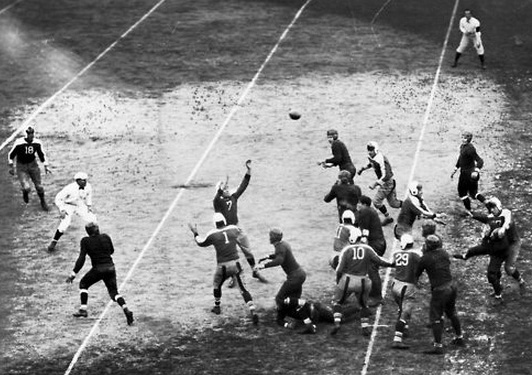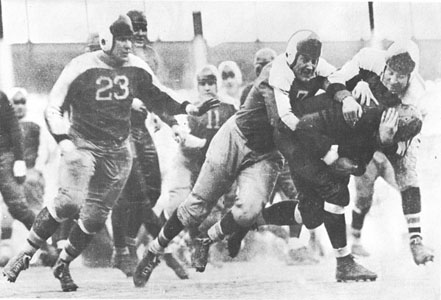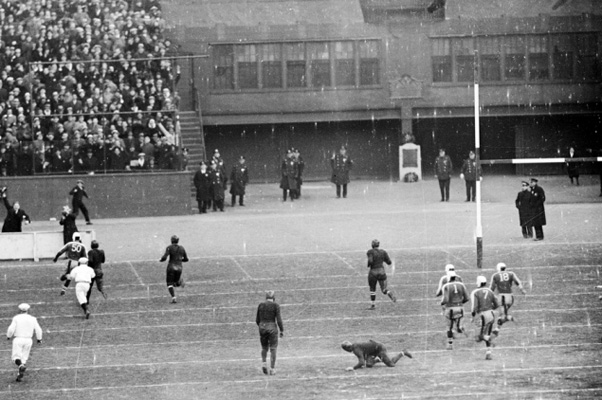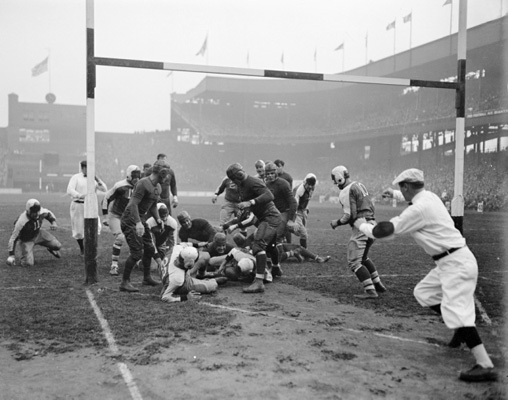|
Pivotal Pro Football Moments
pivotal NFL postseason moment: A decision by a coach or an action by a player that changes the momentum of a playoff game.
1934: Giants Sneakily Come Back in Second Half
NFL Championship Game: Chicago Bears @ New York Giants
The 1934 Chicago Bears dominated the NFL, winning all 13 games despite playing only five at home. The Bears came closest to defeat when they visited the Polo Grounds on November 18. They eked out a 10-9 victory over the New York Giants, whom they had beaten 27-7 at Wrigley Field two weeks earlier.
One of the reasons for the Bears' success was the fact that assistant coach Ralph Jones's offense utilized the widest assortment of formations in the league with over 150 plays. Many were run from the T formation with men in motion, an unheard of concept at the time. They outscored the opposition by exactly 200 points, 286-86.
Halas later wrote: "Our modern T-Formation with man-in-motion was the most successful strategy in football. Even so, very few coaches and players yet saw the lessons. They still continued with the wings and boxes. That was fine with me."
The Giants slumped from 11-3 in '33 to 8-5, but that was still good enough to win the weak East division. Because the right to host the championship game alternated between East and West as the World Series opener did between the two baseball leagues, the Bears traveled to New York for the December 9 meeting at the Polo Grounds. The undefeated Monsters of the Midway entered the fray as a heavy favorite, 8 to 5, to defend their NFL championship.
Adding to the Giants' woes, star E Red Badgro would not play because of an injury. Ken Strong, FB/LB/PK, the New Yorkers' best all-around player, had been badly battered as the season ended but would strive to compete for 60 minutes. Starting QB Harry Newman had injured a vertebrae in the Bears game three weeks earlier, knocking him out for the season.
Conversations took place on the field and in the Giants locker room before the game that would determine the outcome. Three hours before the 2pm kickoff, Jack Mara, Giants president and son of owner Tim Mara, inspected the field and found it better suited to hockey than football. The tarpaulin was frozen to the ground. Mara telephoned Giants coach Steve Owens to inform him about the tricky footing. When the players took the field for their inaptly named "warmups," several stumbled. They kicked at the turf trying vainly to get a foothold. Owens himself slipped on the ice and returned to the clubhouse in despair.
Captain Ray Flaherty told Owens, "Steve, it may sound crazy, but one day when I was playing for Gonzaga, the ground was just like this. We switched from cleats to basketball shoes and got some traction."
But where would you find sneakers on a Sunday morning when sporting goods stores were closed? When the Giants returned to their locker room after their futile pregame workout, Owen mentioned Flaherty's suggestion to trainer Gus Mauch (more famous as the longtime trainer of the New York Yankees of baseball). A light bulb went on in Mauch's head. His 5' assistant Abe Cohen, a tailor by trade, made Manhattan College's uniforms. So Mauch dispatched Abe to the campus (located in the Bronx) in hopes that he might find some sneakers. Unfortunately, the same ice that covered the Polo Grounds made the streets slick as well. So the trip took much longer than usual.
 Bear Keith Molesworth (far right) passes just before being hit, causing an interception. Note the large patch of ice. The Giants began the game shod in their regular cleats just like the Bears. After the home team jumped in front 3-0, the Bears took control, as expected. However, their high-powered offense was diminished by the field conditions. Still, the visitors led at the half 10-3, and the margin could have been worse. Two Chicago touchdowns were nullified by penalties.
When the battered Giants returned to the dressing room, they found sneakers waiting for them. Cohen had scavenged nine pairs. The Giants' cleats, like their opponents', had broken or worn down to the nubs on the hard field in the first half. Strong, knocked out of the game with a leg injury in the second quarter but ready to reenter after the break, put on a pair of sneakers. But many of Ken's teammates eschewed the new footwear when play resumed until they saw how easily he moved around. So more changed shoes during breaks in the action. Even a pair of sneakers that wasn't quite your size served you much better than regular cleats.
 It took more than one Giant to bring down Bronco Nagurski. Halas recalled the start of the second half. "Strong, the kicker, was wearing tennis shoes. His kick squirted sideways, out of bounds. We laughed. He kicked again. The ball sailed into the end zone. We stopped laughing. We started to drive up the field as we had in the first half. We were at the sunny end, but even there icy patches were starting to form. My men slipped and slid and upended. One by one Giants changed into tennis shoes. I shouted to step on their feet. That didn't work either."
The frustrated Bears coach also hollered, "This ain't basketball!," and implored the referee to make the opponents put their cleats back on. But there was no rule against what the Giants were doing.
 Ed Danowski follows the three other backs in second half action. Note the sneakers on the Giants. Nevertheless, the tide didn't turn right away. The Giants still couldn't get their offense rolling. The Bears extended their lead to 13-3 after a fumble recovery set up Jack Manders' 23y field goal. But, whether they knew it or not, they were doomed. E Luke Johnsos recalled, "Some players took off their shoes. That helped a little but not much. I kept my shoes on. I had holes in my socks. We just flipflopped around. The Giants could go anywhere they wished."
New York scored 27 unanswered points in the final period. The onslaught began when Ed Danowski fired a 28y touchdown pass to Ike Frankian to cut the lead to 13-10.
The next score perfectly illustrated the advantage of the sneakers. Running through a hole at left tackle from the Bear 42, Strong brushed an official as he crossed the line of scrimmage but raced on his rubber soles into the open. With an amazing burst of speed, he broke a tackle at the 32 and outran two defenders to the end zone to put NY in front 17-13.
Columbia coach Lou Little had phoned Owen to suggest Strong's scoring play. Noting how much quicker the Giants could cut in their sneakers, Lou advised, "If you send Strong off-tackle, he will be past the line before the Bears have a chance to grab him." Ken said afterward, "Right then, we knew it was over. We could move and they couldn't."
 Strong (50) crosses the goal on his 42y run to put the Giants ahead. A few minutes later, Ken scored again from the 11. Finally, Danowski ran in from the nine to make the final score 30-13.
 Strong scores again. It came to light later that the Giants enjoyed another edge in the game. With the water buckets frozen, trainer Mauch substituted swigs of whiskey from paper cups during timeouts to warm up his charges.
All of New York City rejoiced for winning the title except possibly the Manhattan equipment manager when the Giants returned his battered, misshapen sneakers the next day. |